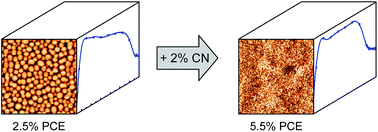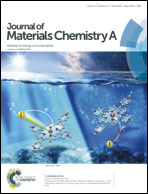Vertical and lateral morphology effects on solar cell performance for a thiophene–quinoxaline copolymer:PC70BM blend†
Abstract
The distribution of electron donor and acceptor in the active layer is known to strongly influence the electrical performance of polymer solar cells for most of the high performance polymer:fullerene systems. The formulation of the solution from which the active layer is spincoated plays an important role in the quest for morphology control. We have studied how the choice of solvent and the use of small amounts of a low vapour pressure additive in the coating solution influence the film morphology and the solar cell performance for blends of poly[2,3-bis-(3-octyloxyphenyl)quinoxaline-5,8-diyl-alt-thiophene-2,5-diyl] (TQ1) and [6,6]-phenyl C71-butyric acid methyl ester (PC70BM). We have investigated the lateral morphology using atomic force microscopy (AFM) and scanning transmission X-ray microscopy (STXM), the vertical morphology using dynamic secondary ion mass spectrometry (d-SIMS) and variable-angle spectroscopic ellipsometry (VASE), and the surface composition using near-edge X-ray absorption fine structure (NEXAFS). The lateral phase-separated domains observed in films spincoated from single solvents, increase in size with increasing solvent vapour pressure and decreasing PC70BM solubility, but are not observed when 1-chloronaphthalene (CN) is added. A strongly TQ1-enriched surface layer is formed in all TQ1:PC70BM blend films and rationalized by surface energy differences. The photocurrent and power conversion efficiency strongly increased upon the addition of CN, while the leakage current decreased by one to two orders of magnitude. The higher photocurrent correlates with the finer lateral structure and stronger TQ1-enrichment at the interface with the electron-collecting electrode. This indicates that the charge transport and collection are not hindered by this polymer-enriched surface layer. Neither the open-circuit voltage nor the series resistance of the devices are sensitive to the differences in morphology.


 Please wait while we load your content...
Please wait while we load your content...